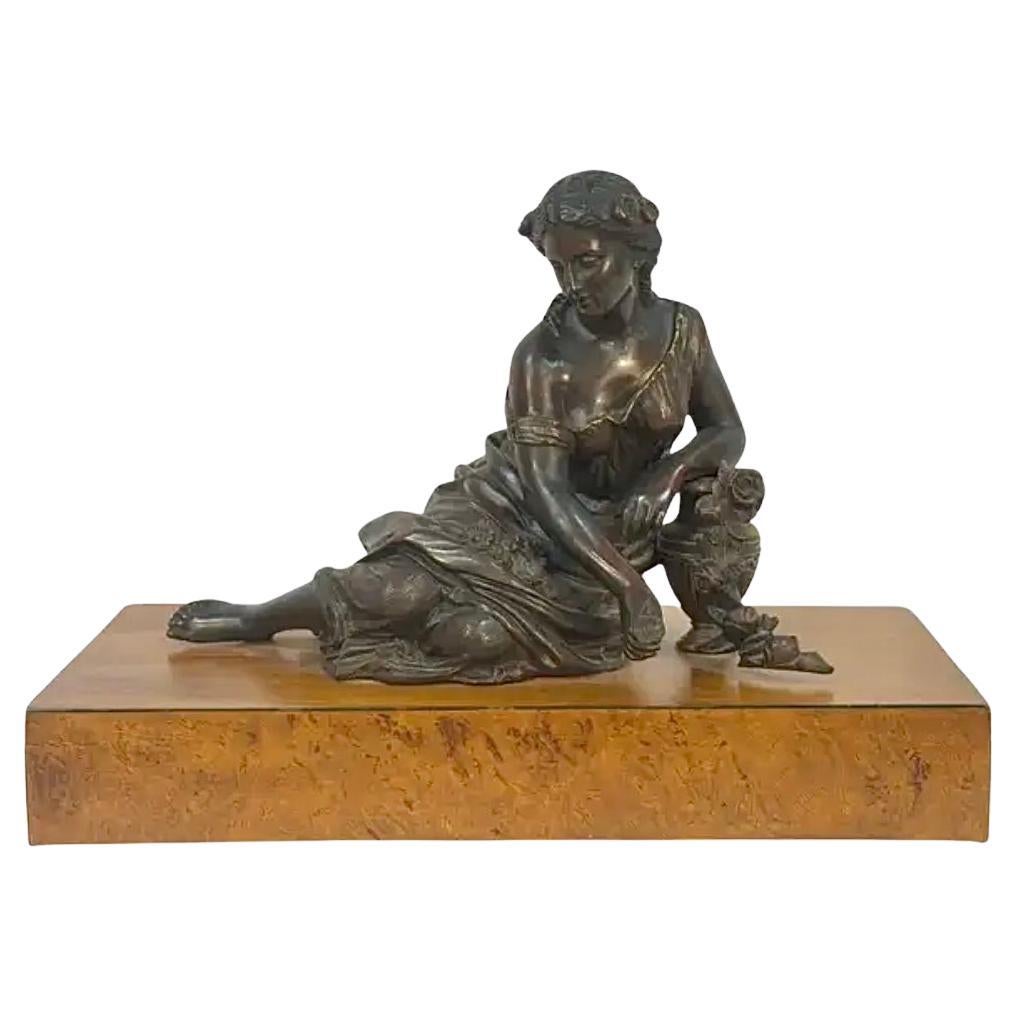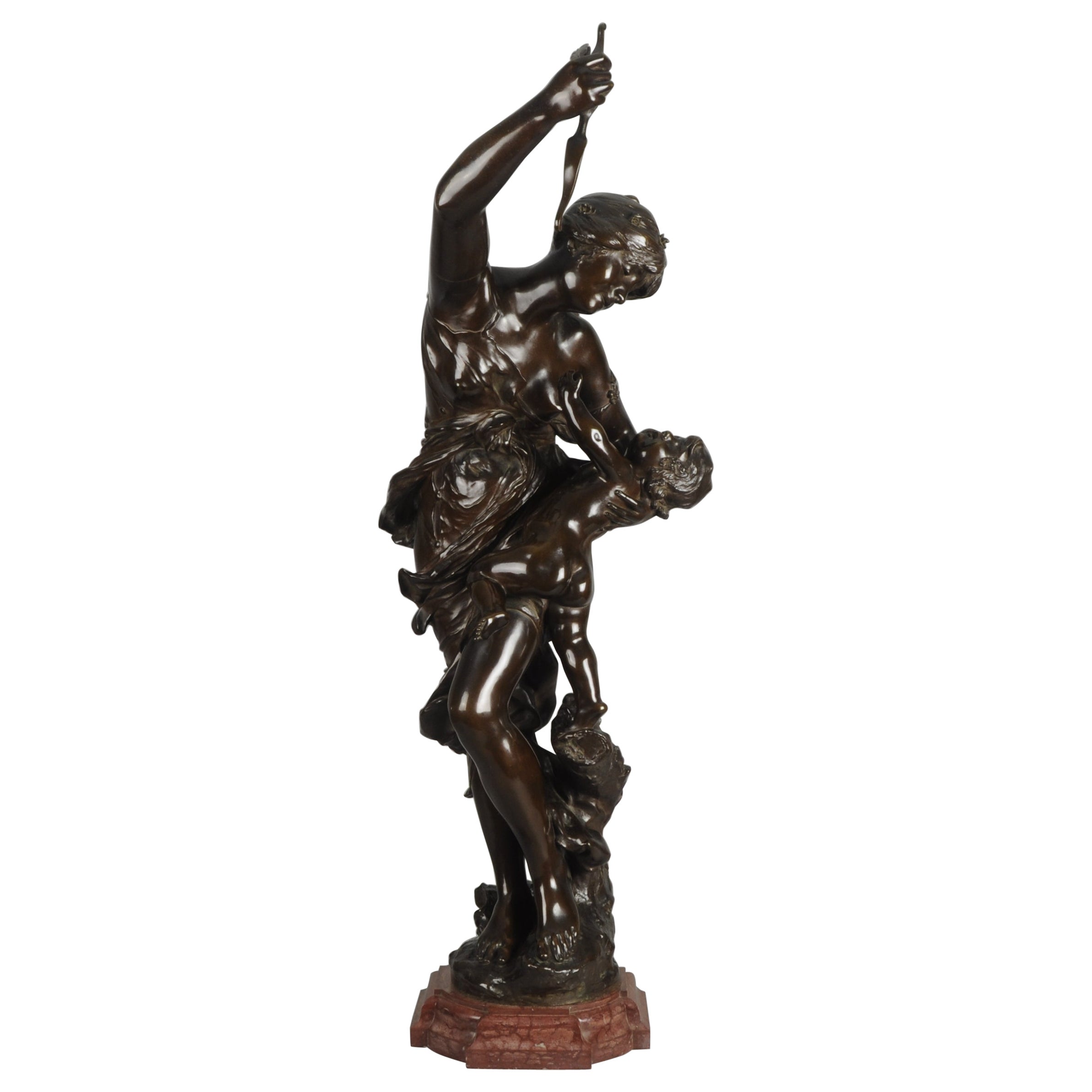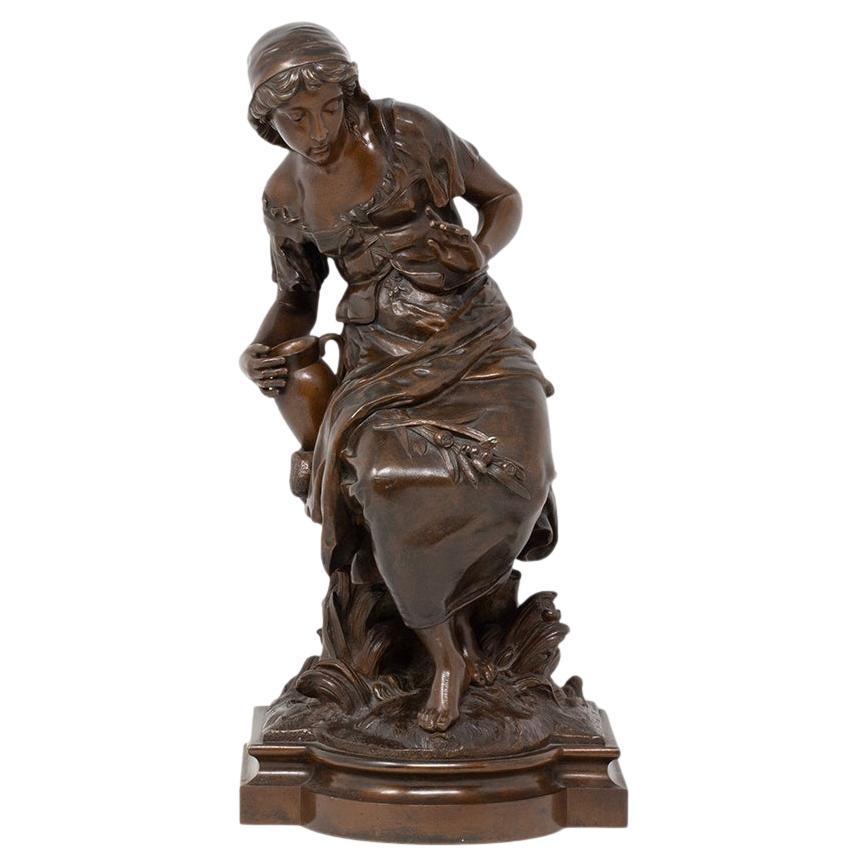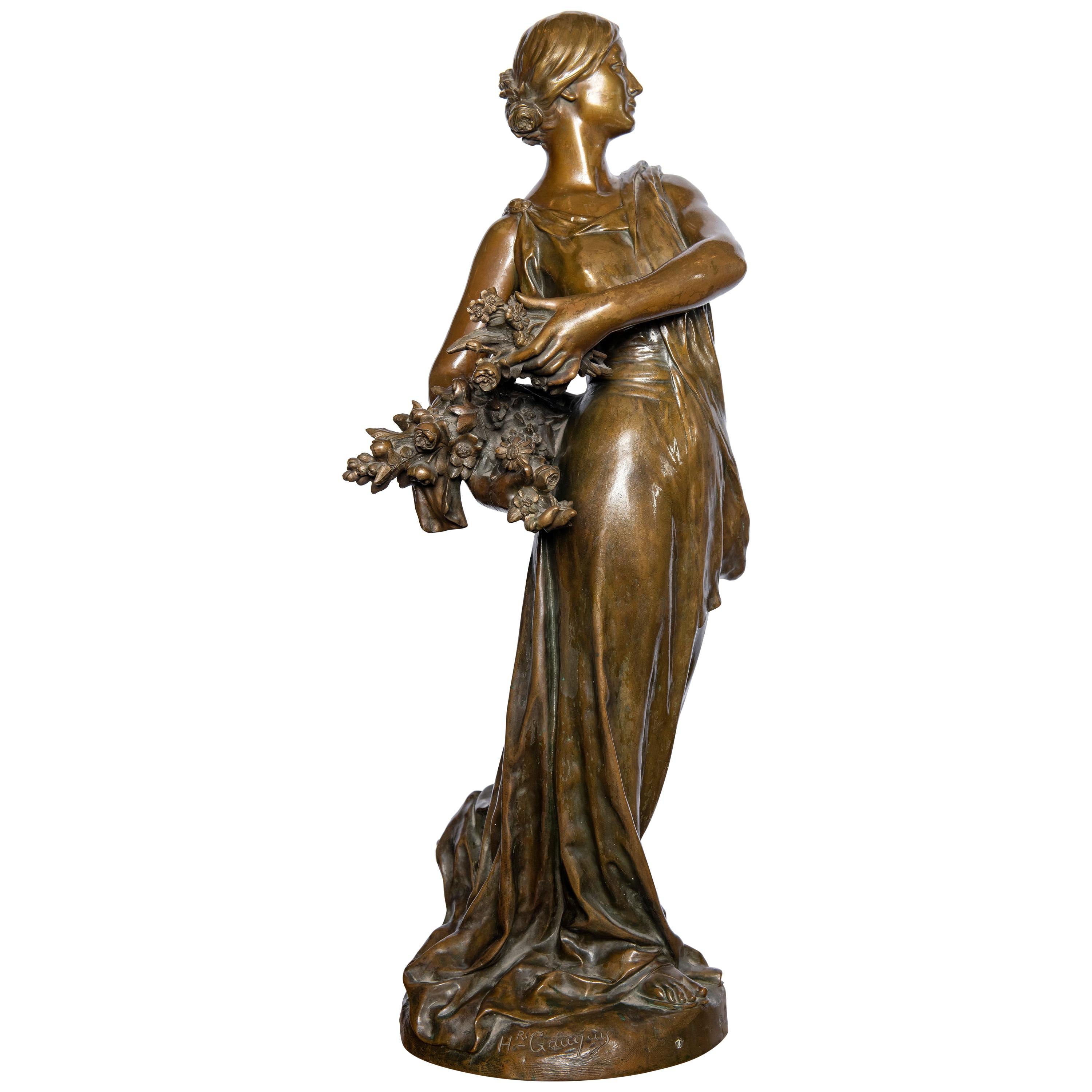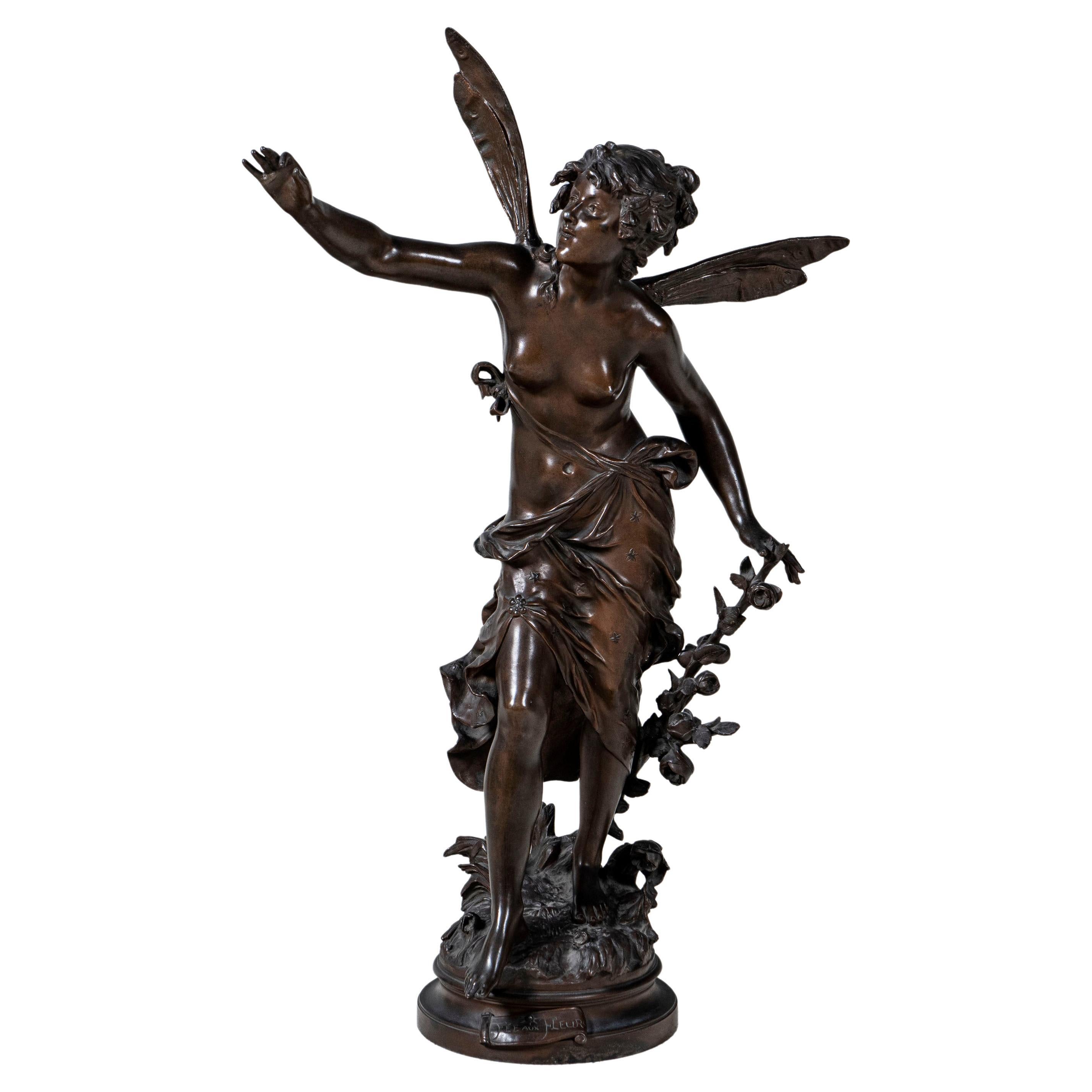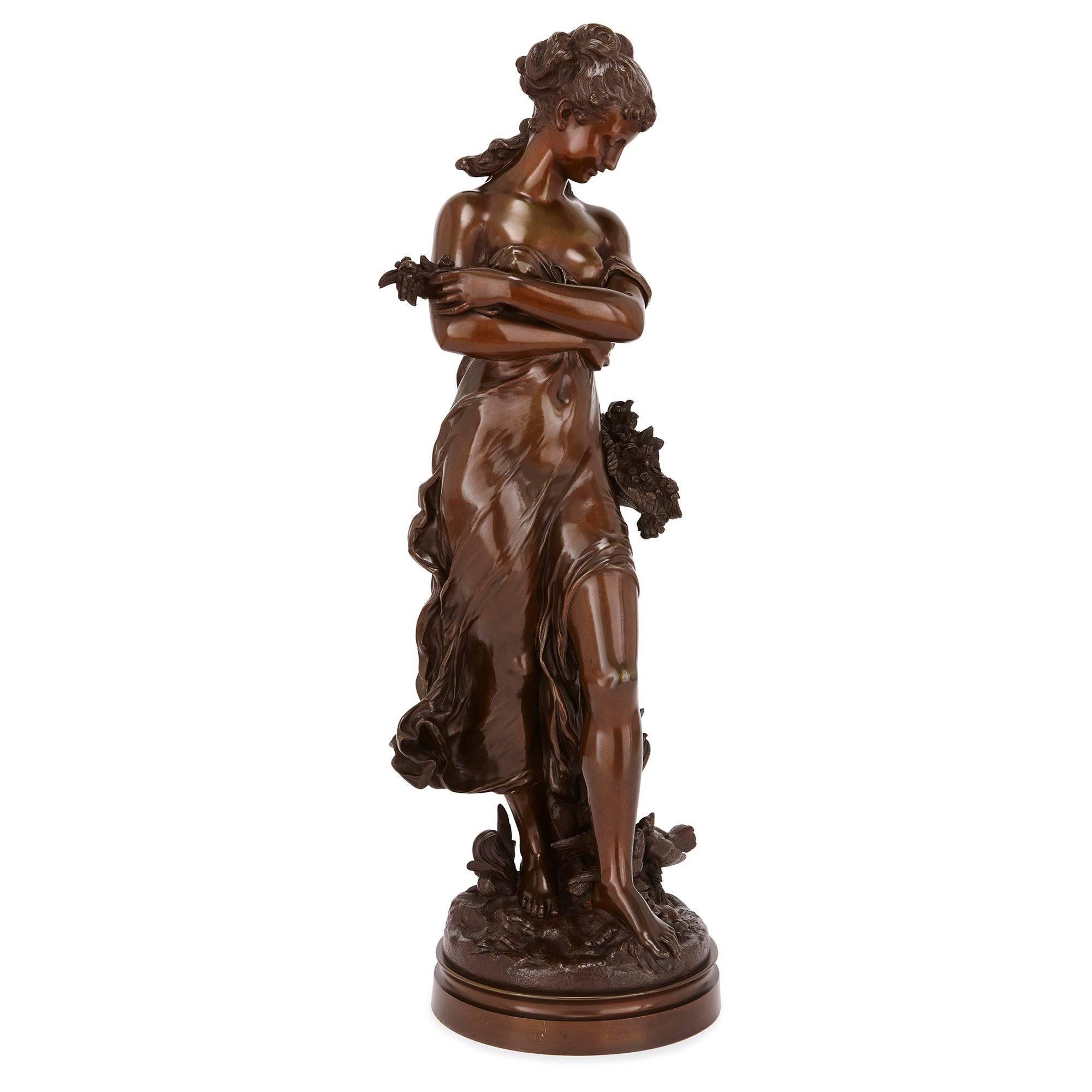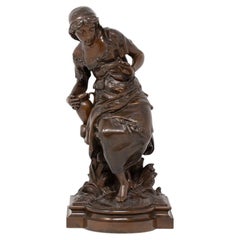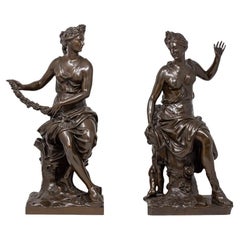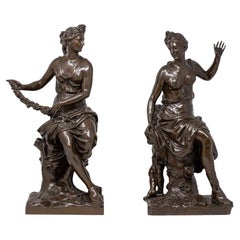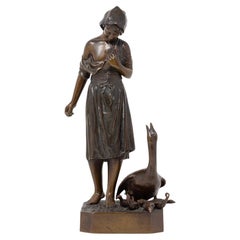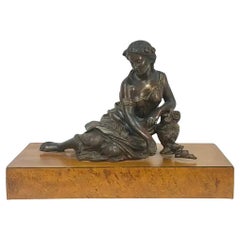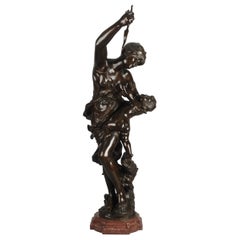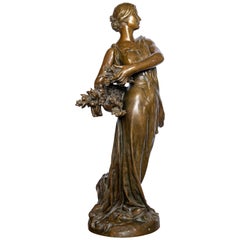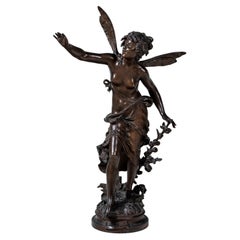Items Similar to Antique Belgian Bronze Figure Fleur d’amour by Auguste de Wever
Want more images or videos?
Request additional images or videos from the seller
1 of 21
Antique Belgian Bronze Figure Fleur d’amour by Auguste de Wever
$5,507.38
£4,000
€4,722.25
CA$7,575.08
A$8,425.67
CHF 4,420.09
MX$102,812.26
NOK 55,477.74
SEK 52,281.04
DKK 35,249.63
About the Item
AUGUSTE DE WEVER (1836-1910)
From our Bronze Sculpture collection, we are delighted to offer this superb Auguste de Wever Fleur d’amour Belgian Bronze Figure. The Sculpture modelled in bronze features a seated maiden upon a column with ivy growing up the base and a pair of turtle doves to her feet. The maiden scantily clad sits with her arms in the air holding a bunch of flowers as she peers down at cupid resting on her knees. The Bronze Figure is signed around the base Aug De Wever for Auguste de Wever (1836-1910) and with the model Fleur D’amour meaning Flower of Love. The Auguste de Wever Fleur d’amour Belgian Bronze Figure is a classic romantic sculpture dating to the second half of the 19th century circa 1860 during the reign of Napoleon III.
AUGUSTE DE WEVER (1836-1910)
Although de Wever was a known sculptor producing high quality figures, there is very little known about his life and career. De Wever was born in Belgium and most likely moved to Paris to further his career. He began his metal working career under Charles Wiener learning the art of making medallions and through his medallion career he began to design sculptures in the prevailing Parisian fashion of the time. He became well-known for his romantic allegorical figures, opera characters and “genre” pieces. De Wever worked with the Compagnie des Bronzes foundry for the majority of his casting and his work can be found in the Royal Museum of Fine Arts in Brussels.
- Creator:Auguste de Wever (Maker)
- Dimensions:Height: 24.41 in (62 cm)Width: 8.67 in (22 cm)Depth: 7.88 in (20 cm)
- Style:Rococo (In the Style Of)
- Materials and Techniques:
- Place of Origin:
- Period:
- Date of Manufacture:Circa 1860
- Condition:Wear consistent with age and use. Minor fading.
- Seller Location:Newark, GB
- Reference Number:Seller: KRDYS1stDibs: LU6971244452032
About the Seller
5.0
Gold Seller
Premium sellers maintaining a 4.3+ rating and 24-hour response times
Established in 2019
1stDibs seller since 2022
37 sales on 1stDibs
Typical response time: 2 hours
- ShippingRetrieving quote...Shipping from: Newark, United Kingdom
- Return Policy
Authenticity Guarantee
In the unlikely event there’s an issue with an item’s authenticity, contact us within 1 year for a full refund. DetailsMoney-Back Guarantee
If your item is not as described, is damaged in transit, or does not arrive, contact us within 7 days for a full refund. Details24-Hour Cancellation
You have a 24-hour grace period in which to reconsider your purchase, with no questions asked.Vetted Professional Sellers
Our world-class sellers must adhere to strict standards for service and quality, maintaining the integrity of our listings.Price-Match Guarantee
If you find that a seller listed the same item for a lower price elsewhere, we’ll match it.Trusted Global Delivery
Our best-in-class carrier network provides specialized shipping options worldwide, including custom delivery.More From This Seller
View AllFrench Antique Bronze Sculpture by Eutrope Bouret
By Eutrope Bouret
Located in Newark, England
Lady and the Bee
From our Bronze Sculpture collection, we are delighted to offer this beautiful French Bronze Sculpture by Eutrope Bouret. The Sculpture modelled in bronze with a su...
Category
Antique Late 19th Century French Belle Époque Figurative Sculptures
Materials
Bronze
French Bronze Figures Allégorie du Printemps Barbedienne
By Ferdinand Barbedienne
Located in Newark, England
OPPOSING PAIR OF BRONZE FIGURES
Form our Bronze Sculpture collection, we are delighted to offer this French opposing pair of Bronze Figures Allégorie du Printemps by Ferdinand Barb...
Category
Antique Mid-19th Century French Louis XIV Figurative Sculptures
Materials
Bronze
French Bronze Opposing Figures Allégorie du Printemps Ferdinand Barbedienne
By Ferdinand Barbedienne
Located in Newark, England
OPPOSING PAIR OF BRONZE FIGURES
Form our Bronze Sculpture collection, we are delighted to offer this French opposing pair of Bronze Figures Allégorie du Printemps by Ferdinand Barb...
Category
Antique Mid-19th Century French Napoleon III Figurative Sculptures
Materials
Bronze
Antique German Bronze Figure by Hermann Gladenbeck
Located in Newark, England
GIRL WITH GOSLINGS
From our Antique Bronze Sculptures collection, we are delighted to offer this German Bronze Figure by Hermann Gladenbeck. The Bronze beautifully cast with a dark...
Category
Antique Early 1900s German Art Nouveau Figurative Sculptures
Materials
Bronze
French Bronze Ariadne After Clodion
By Claude Michel Clodion
Located in Newark, England
Signed Clodion
From our Sculpture collection, we are pleased to offer this French Belle Epoque Bronze of Ariadne cast after Clodion (Claude Michel). The sculpture of fine casting and beautiful patination is sculpted as a bust of a Ariadne in nature with her hair tied up and leaves intwined in her hair. The Bronze sits upon a circular socle with a square base signed to the right hand face Clodion. The Bronze cast after the original during the neoclassical era dating to the second half of the 19th century during the Belle Epoque era (c.1970-1914) circa 1875.
Clodion was the alias of Claude Michel (1738-1814) a French born sculptor working in the Rococo style, especially noted for his works in marble, bronze, & terracotta. Many of Clodion’s works feature in museum collections around the world with some of his most pivotal works including The Intoxication of Wine and The Dance of Time.
Ariadne In Greek mythology was a Cretan princess and the daughter of King Minos of Crete. Ariadne was known for aiding Theseus escape the Minotaur and then being abandoned by him on the island of Naxos. There, Dionysus saw Ariadne sleeping, fell in love with her, and later married her. Many versions of the myth recount Dionysus throwing Ariadne’s jewelled crown into the sky to create a constellation, the Corona Borealis...
Category
Antique Late 19th Century French Belle Époque Busts
Materials
Bronze
French Bronze Figure by Jean Didier Debut
By Jean Didier Debut
Located in Newark, England
NAMED PORTEUR D’EAU TUNISIEN
From our Antique Bronze Sculpture collection, we are delighted to offer this French Bronze Figure by Jean Didier Debut. The figure named Porteur d’eau Tunisien (Tunisian Water Bearer) is exceptionally cast upon a slightly rounded plinth base with a natural textured surface. The figure stands bearing two pales of water dressed...
Category
Antique Late 19th Century French Belle Époque Figurative Sculptures
Materials
Bronze
You May Also Like
19th Century French Bronze Woman With Flowers Sculpture
Located in Bradenton, FL
19th Century French Bronze Woman with flowing garments amid flowers and an urn. Flowers often represented beauty, life and the passage of time while urns are traditional symbols of m...
Category
Antique 19th Century French French Provincial Figurative Sculptures
Materials
Bronze
19th Century Art Nouveau Bronze Entitled "Venus & Cupid" by Jean Sul-Abadie
By Jean Abadie
Located in London, GB
A very fine bronze study of Venus taking an arrow from Cupid her son, who at times would shoot his arrows without meaning or reason into the hearts of men, igniting their desire. Exhibiting excellent rich brown patina and good detail, signed Sul Abadie and stamped.
Additional information
Height: 93 cm
Condition: excellent condition
Circa: 1885
Materials: bronze & marble
SKU: 4979
ABOUT
Jean Sul-Abadie
Jean Sul-Abadie (Born 1850 ~ Died 15th April 1890) was a French artist, a pupil of Jouffroy and Falguière. Specialising in bronze sculpting in the Art Nouveau style. He made his Salon debut in 1872.
Cupid & Venus
Different tales exist about the origin of Venus and Cupid. Some say that Venus, the goddess of love and beauty, had a love affair with Mars, the god of war. Out of this relationship, Cupid was born. In the following painting you see Venus with Mars, who is being disarmed by Cupid.
Cupid has attributes from both of his parents. Like his mother he is considered to be the god of love, or more precisely, the god of falling in love. He is portrayed as an innocent little child with bow and arrows. He shoots arrows to the heart, and awakening a love that you’re powerless to resist.
In classical mythology, Cupid (Latin Cupido, meaning “desire”) is the god of desire, erotic love, attraction and affection. He is often portrayed as the son of the love goddess Venus and the war god Mars, and is known in Latin also as Amor (“Love”). His Greek counterpart is Eros.
Although Eros is in Classical Greek art as a slender winged youth, during the Hellenistic period, he was increasingly portrayed as a chubby boy. During this time, his iconography acquired the bow and arrow that represent his source of power: a person, or even a deity, who is shot by Cupid’s arrow is filled with uncontrollable desire. In myths, Cupid is a minor character who serves mostly to set the plot in motion. He is a main character only in the tale of Cupid and Psyche, when wounded by his own weapons he experiences the ordeal of love. Although other extended stories are not told about him, his tradition is rich in poetic themes and visual scenarios, such as “Love conquers all” and the retaliatory punishment or torture of Cupid.
In art, Cupid often appears in multiples as the Amores, or amoriniin the later terminology of art history, the equivalent of the Greek erotes. Cupids are a frequent motif of both Roman art and later Western art of the classical tradition. In the 15th century, the iconography of Cupid starts to become indistinguishable from the putto.
Cupid continued to be a popular figure in the Middle Ages, when under Christian influence he often had a dual nature as Heavenly and Earthly love. In the Renaissance, a renewed interest in classical philosophy endowed him with complex allegorical meanings. In contemporary popular culture, Cupid is shown drawing his bow to inspire romantic love, often as an icon of Valentine’s Day.
Venus is the Roman goddess whose functions encompassed love, beauty, sex, fertility, prosperity, victory, and desire. In Roman mythology, she was the mother of the Roman people through her son, Aeneas, who survived the fall of Troy...
Category
Antique Late 19th Century French Art Nouveau Figurative Sculptures
Materials
Breccia Marble, Bronze
Bronze Sculpture Signed H. Gauquie, France, Late 19th Century
By Henri Desire Gauquie
Located in Buenos Aires, Buenos Aires
Bronze sculpture signed H. Gauquie, France, late 19th century.
Category
Antique Late 19th Century French Art Nouveau Figurative Sculptures
Materials
Bronze
$11,200 Sale Price
20% Off
Bronze Alloy Sculpture, Signed L. Moreau, France, Late 19th Century
By Louis Auguste Moreau
Located in Buenos Aires, Buenos Aires
Bronze Alloy sculpture "Fée Aux Fleurs", Signed L. Moreau, France, Late 19th Century.
Category
Antique Late 19th Century French Art Nouveau Figurative Sculptures
Materials
Bronze
19th Century Bronze Sculpture of a Lady by Moreau
By Hippolyte François Moreau
Located in London, GB
This alluring bronze depicts the full-length figure of a young lady who, swathed in draped clothing, looks downward toward a basket of flowers hung about her waist. The circular base...
Category
Antique Late 19th Century French Belle Époque Figurative Sculptures
Materials
Bronze
$7,159 Sale Price
20% Off
Protection Bronze Sculpture by Francois Moreau, 19th Century
By Hippolyte François Moreau
Located in Lisbon, PT
A bronze statue, two girls with the loose tunic in the wind hugging each other - Persephone the Goddess of Protection embraces the smallest girl in an act of protection.
Possesses a...
Category
Antique 19th Century French Neoclassical Figurative Sculptures
Materials
Bronze
$7,026 Sale Price
33% Off
More Ways To Browse
Antique Ivy
Napoleon Medallions
Bronze Turtle Sculptures
Turtle Seat
Giallo Siena
Roman Gladiator
Sabine Women
Sailor Sculptures
Wood Female Torso
1930 Sculpture Male Figure
Antique Pieta
Antique Spelter Figures
Art Deco Resin Sculpture
Bronze Statue On Marble Pedestal
Capodimonte Flower
Carved Driftwood Sculpture
Carved Indian Statue
Don Quixote Sculpture
